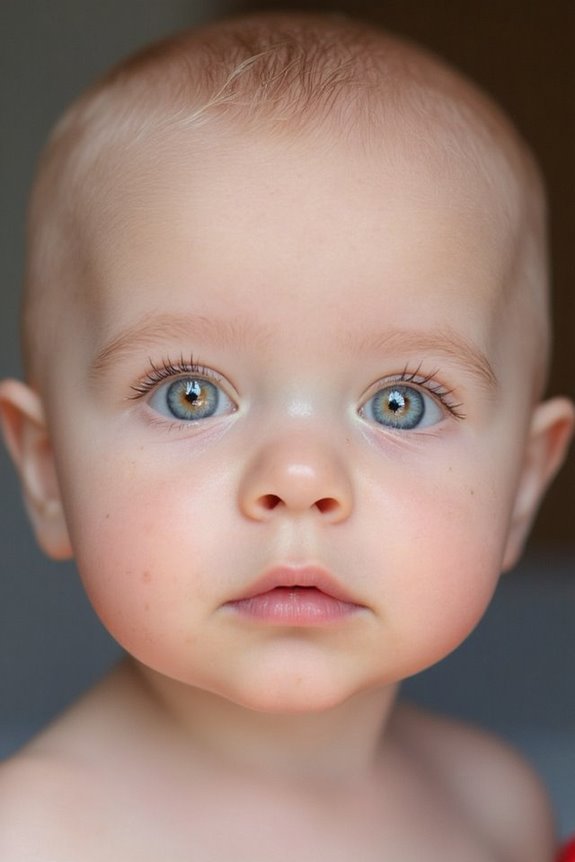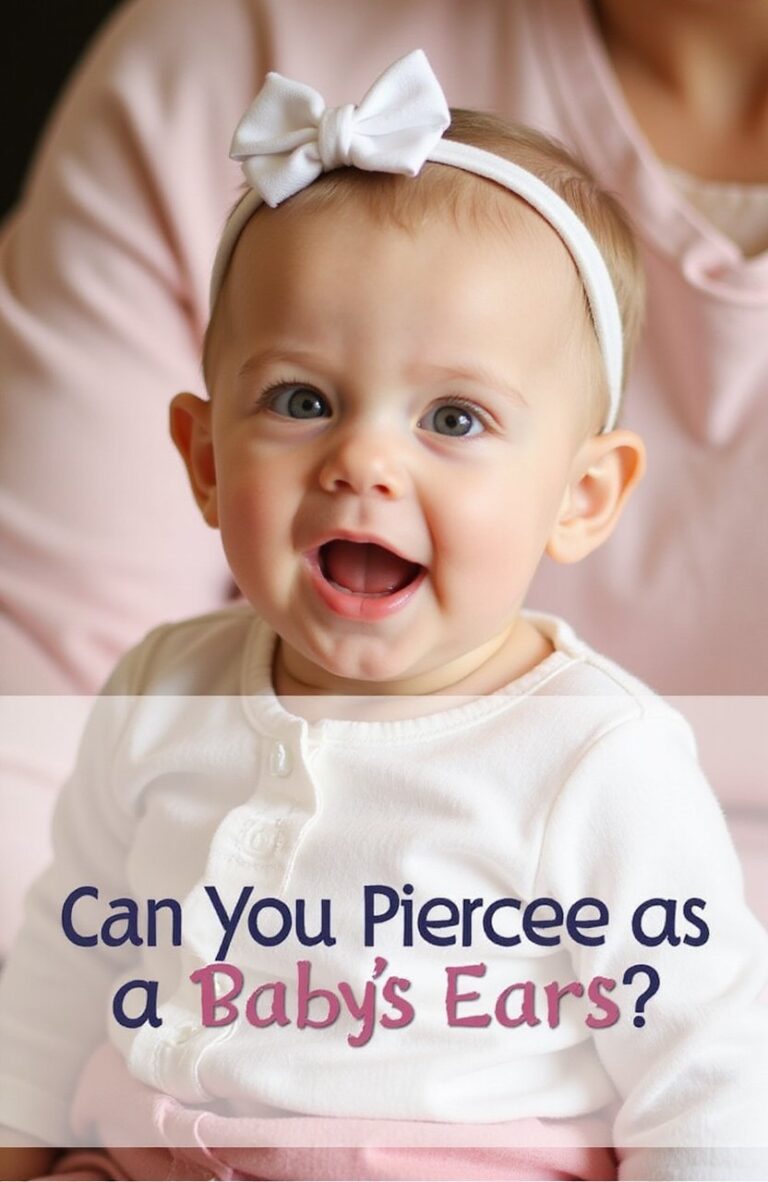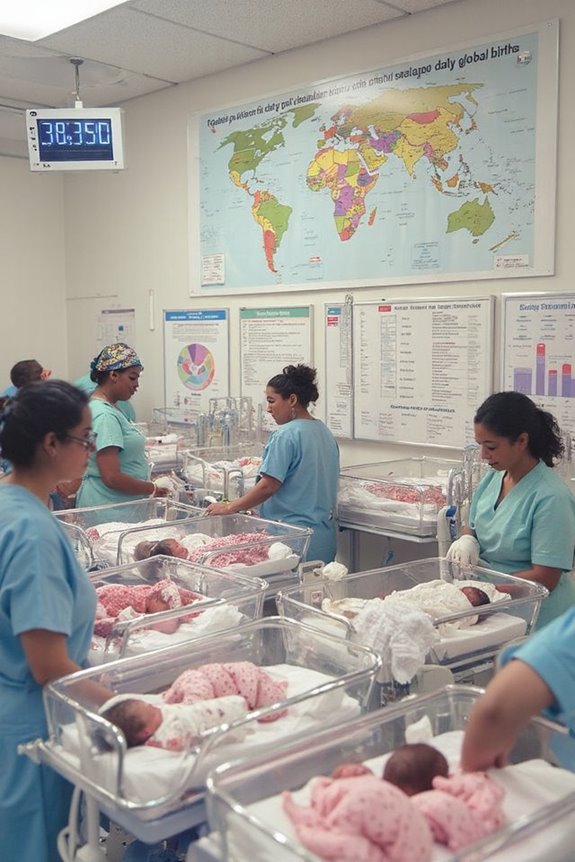Most babies’ eyes begin changing color between 3-6 months as melanin accumulates in the iris. Born with blue or gray eyes, infants gradually develop their permanent eye color by 9 months, though subtle changes may continue until 12 months. The process is determined by multiple genes controlling melanin production, with final color typically stabilizing before their first birthday. Family history provides clues, but the complex genetic interplay makes precise prediction challenging. Explore the fascinating timeline of this natural transformation below.
Key Takeaways
- Most babies are born with blue or gray eyes due to low melanin levels at birth.
- Significant eye color changes begin between 3-6 months as melanin accumulates in the iris.
- Most infants establish their permanent eye color by 9 months of age.
- Eye color typically stabilizes by 12 months, though subtle changes may continue until age 3.
- Babies with African or Asian ancestry often develop brown eyes earlier than those of European descent.
The Science Behind Newborn Eye Color
When you first gaze into your newborn’s eyes, you might be surprised to learn that the color you see isn’t permanent. That’s because eye color development is a complex process influenced by over 50 different genes.
Your baby’s eye color results from:
- Genetic variability inherited from both parents
- The amount of melanin produced in the iris
- How pigment distribution occurs throughout the stroma layer
Most newborns have blue or gray eyes because melanin production hasn’t fully activated yet. As melanin develops in the months following birth, your baby’s true eye color will emerge. This process can take up to a year, sometimes longer.
The interaction between different pigments (melanin, eumelanin, and pheomelanin) and how they’re dispersed throughout the iris ultimately determines your child’s permanent eye color.
Timeline of Eye Color Development in Infants
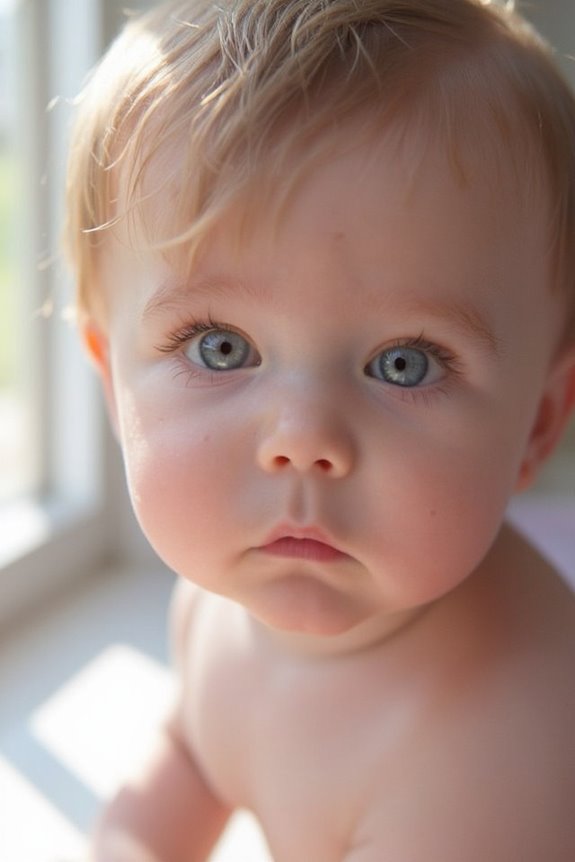
Although your baby’s eye color may appear set at birth, it’s actually just the beginning of a fascinating development process that unfolds over their first year of life. I’ve outlined the typical infant eye development stages below:
- 0-3 months: Most babies start with blue or gray eyes (lighter in Caucasian infants, potentially darker in BIPOC infants)
- 3-6 months: Significant eye color variations begin as melanin accumulates
- 6-9 months: More pronounced changes occur as melanin production continues
- 9 months: Most infants have established their permanent eye color
- 9-12 months: Subtle refinements may still occur
- 12+ months: Eye color is generally stable, though minor adjustments can happen until age 3
Genetics primarily determine your baby’s final eye color, while environmental factors have minimal influence.
How Melanin Influences Your Baby’s Eye Color
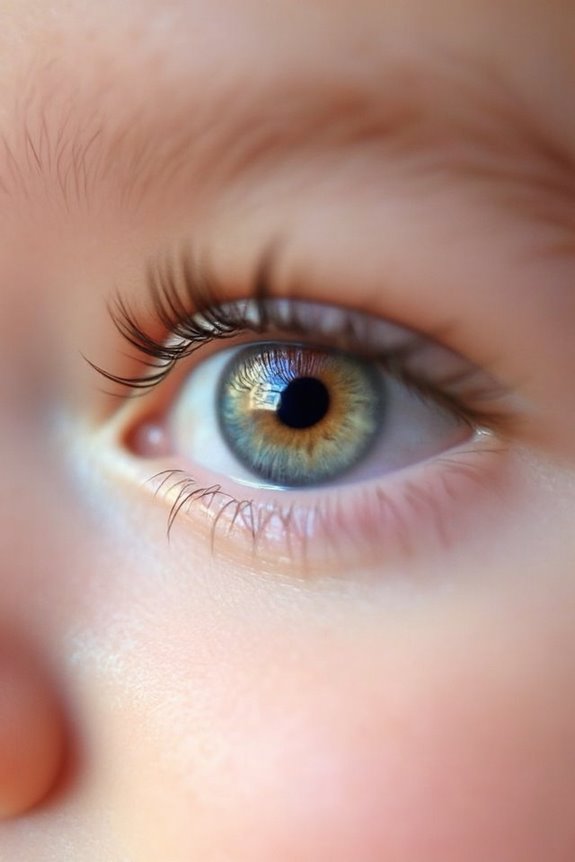
Melanin plays the starring role in your baby’s eye color development, acting as the biological pigment that determines whether those adorable eyes will remain blue or transform to green, hazel, or brown. This process begins during the third trimester but continues after birth as melanin gradually accumulates in the iris.
There are two melanin types affecting eye color:
- Eumelanin: produces brown pigmentation
- Pheomelanin: creates red/yellow tones
The iris structure also impacts how we perceive eye color. The way melanin distributes throughout the iris’s layers creates various color effects. More melanin generally results in darker eyes, while less produces lighter colors.
While genetics largely control melanin production, the unpredictable rate of accumulation makes it difficult to forecast your baby’s final eye color with certainty.
Genetic Factors That Determine Final Eye Color

The intricate dance of genes ultimately decides your baby’s final eye color. Unlike what you might have learned in school, eye color isn’t determined by a single gene but by multiple genes working together.
Key genetic players include:
- OCA2 and HERC2 genes on chromosome 15, which control brown/blue color spectrum
- TYR and TYRP1 genes that regulate melanin production
- SLC24A4 gene involved in melanin transport
This polygenic inheritance explains the wide eye color variability we see. When I counsel new parents, I emphasize that predicting your baby’s final eye color is challenging because of these complex genetic interactions. Specific variants in these genes—like certain HERC2 variants that reduce OCA2 expression—can result in blue eyes, while other combinations produce different colors.
Common Eye Color Transformations in the First Year
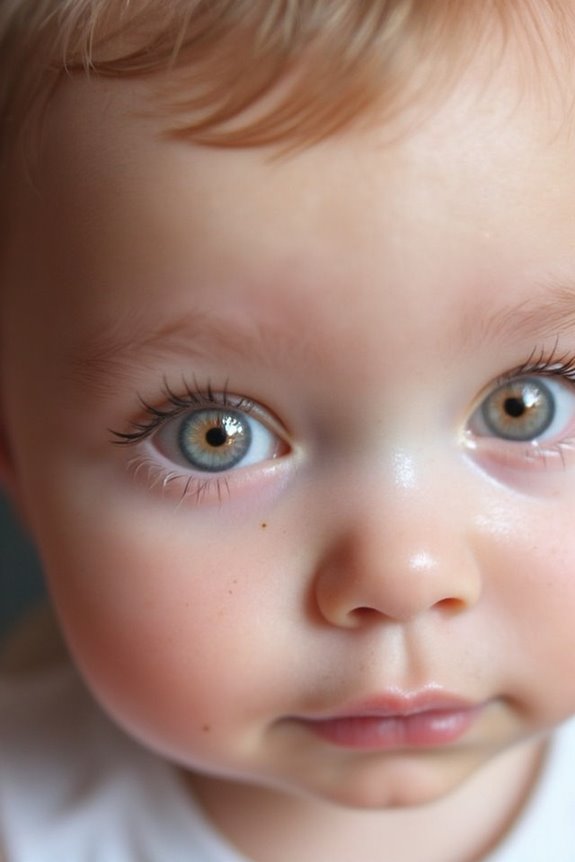
When you first gaze into your newborn’s eyes, you’re likely looking at a shade that won’t last. Most babies experience significant eye color transformations during their first year of life.
The most common baby eye changes include:
- Blue to brown: As melanin production increases, many initially blue eyes darken
- Gray to green: Slate-colored eyes may develop green tones as pigmentation evolves
- Slate to brown: This is another frequent transformation pattern
These changes happen most dramatically between 3-6 months, with the pace slowing afterward. By 9 months, your baby’s final eye color becomes more predictable, though subtle shifts may continue until their first birthday. Some children’s eyes may even continue changing subtly until age 3, though this is less common.
Ethnic and Racial Patterns in Baby Eye Color
Genetic heritage plays a significant role in determining your baby’s initial eye color, with distinct patterns emerging across different ethnic backgrounds.
When examining ethnic variations in newborn eye color:
- African and Asian ancestry babies typically have brown eyes at birth due to higher melanin levels
- European descent infants often display lighter blue eyes initially
- Mixed-ancestry babies may show unique combinations, including green or hazel
These racial influences stem from evolutionary adaptations to regional sunlight conditions. For example, darker eyes in African populations provide better protection against intense sunlight. Most babies’ eye colors stabilize between 6-12 months, though some continue changing until age 3.
It’s important to understand that while ethnicity creates general patterns, multiple genes interact in complex ways, meaning your baby’s final eye color may still surprise you regardless of your family’s heritage.
Predicting Your Baby’s Permanent Eye Color
While ethnic heritage influences a baby’s initial eye color, parents are often curious about their child’s permanent eye color. Understanding eye color inheritance can help set realistic expectations, though precise prediction remains challenging.
Some guidelines to evaluate:
- If both parents have blue eyes, your baby will likely keep blue eyes
- Brown-eyed parents can have blue-eyed babies if grandparents had blue eyes
- Melanin production, which determines eye color, increases after birth
- Most significant eye color changes occur between 3-6 months
- Final eye color typically stabilizes by 6-12 months
Despite tools like Punnett squares that calculate genetic probability, multiple genes influence eye color, making prediction uncertain. Family history provides helpful clues, but the complex interaction of genetics and environment means your baby’s permanent eye color remains a beautiful surprise until it stabilizes.
Myths vs. Facts About Infant Eye Color Changes
Many parents hold misconceptions about their newborn’s eye color development, often expecting the shade they see at birth to remain unchanged. This is among the most common myths requiring clarification.
Key facts to understand:
- Most babies experience significant color changes between 3-9 months as melanin accumulates
- By 9 months, most infants have their permanent eye color, though subtle changes can continue until age 3
- Color prediction at birth has limited accuracy, as genetic expression varies
- Eye color isn’t always fixed by one year of age
While Caucasian babies typically show more dramatic changes from light to darker colors, BIPOC infants often maintain their darker eye color from birth. The iris development process is complex and influenced by multiple genetic factors.
Frequently Asked Questions
Can Illness or Medication Affect a Baby’s Eye Color?
Yes, while color genetics primarily determine your baby’s eye color, certain illnesses and medications like glaucoma treatments can temporarily or permanently affect eye health and appearance. I’d recommend consulting a pediatrician about any changes.
Do Premature Babies Follow the Same Eye Color Timeline?
Like a rose unfolding at its own pace, premature babies often have their own timeline. I’ve found they typically follow a similar color genetics pattern, but their premature development may slightly delay melanin production compared to full-term infants.
Can Heterochromia (Different Colored Eyes) Develop After Birth?
Yes, I can confirm heterochromia can develop after birth. It’s often linked to genetic factors that affect eye pigmentation. While some babies are born with it, others may develop this condition shortly after birth.
Do Siblings Always Follow Similar Eye Color Change Patterns?
No, I’ve observed that siblings don’t always follow similar eye color change patterns. While they share genetic factors, unique genetic combinations can result in different sibling eye color development timelines and final outcomes.
Can Eye Color Change Again During Puberty or Adulthood?
You might wonder if eye color is fixed after childhood. I’ve found that for some individuals, hormonal changes during puberty can indeed trigger subtle shifts in eye color genetics, though it’s relatively uncommon (10-15% of Caucasians).
References
https://www.pampers.com/en-us/baby/development/article/when-do-babies-eyes-change-color
https://www.whattoexpect.com/first-year/ask-heidi/baby-eye-color.aspx
https://www.babycenter.com/baby/newborn-baby/will-my-babys-eyes-stay-this-color_10009
https://www.ophthalmology24.com/baby-eye-color-change
https://www.dmei.org/blog/when-do-a-babys-eyes-change-color/
https://www.verywellhealth.com/genetics-of-eye-color-3421603
https://www.allaboutvision.com/eye-care/eye-anatomy/eye-color/genetics/
https://opticasavenida.com/en/my-baby-eye-color/
https://medlineplus.gov/genetics/understanding/traits/eyecolor/
https://www.visionlearncenter.com/post/the-evolution-of-baby-eye-color

